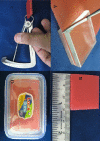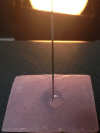Evaluation of wetting ability of five new saliva substitutes on heat-polymerized acrylic resin for retention of complete dentures in dry mouth patients: a comparative study
- PMID: 29187918
- PMCID: PMC5687871
- DOI: 10.11604/pamj.2017.27.185.9098
Evaluation of wetting ability of five new saliva substitutes on heat-polymerized acrylic resin for retention of complete dentures in dry mouth patients: a comparative study
Abstract
Introduction: The aim of this study was to evaluate & compare the wetting ability of five saliva substitutes & distilled water on heat-polymerized acrylic resin. Contact angle of the saliva substitute on denture base can be taken as an indicator of wettability. Good wetting of heat-polymerized acrylic resin is critical for optimum retention of complete dentures.
Methods: Two hundred & forty samples of heat-polymerized acrylic resin were fabricated using conventional method. 240 samples divided into 6 groups with 40 samples in each group. Advancing & Receding contact angles were measured using Contact Angle Goniometer & DSA4 software analysis.
Results: Anova test was carried out to test the significance in difference of contact angle values in the six groups. The mean of advancing angle values & mean of receding angle values of all the six groups has shown statistically significant difference between the groups. The mean of angle of hysteresis values of all the six groups are statistically not significant between the groups. A multiple comparison using Bonferroni's test was carried out to verify the significance of difference between the contact angles in a pair of groups. Statistically significant difference was seen when Aqwet (Group II) was compared to Distilled water (Group I), Wet Mouth (Group III), E-Saliva (Group IV), Biotene (Group V), and Moi-Stir (Group VI).
Conclusion: The contact angles of five saliva substitutes and distilled water were measured and compared. Group II (AQWET) has the lowest advancing and receding contact angle values and the highest angle of hysteresis on heat-polymerized acrylic resin. Based on contact angle values, Group II (AQWET) has the best wetting ability on heat-cured acrylic resins. The ability of saliva to wet the denture surface is one of the most important properties for complete denture retention in dry mouth cases.
Keywords: Wettability; denture; retention; saliva; xerostomia.
Figures







References
-
- Joel Napeñas J, Michael Brennan T, Philip Fox C. Diagnosis and treatment of xerostomia (dry mouth) Odontology. 2009 Jul;97(2):76–83. - PubMed
-
- Kevser Aydin A, Hakan Terzioglu, Kezban Ulubayram, Nesrin Hasirci. Wetting properties of saliva substitutes on acrylic resin. Int J Prosthodont. 1997 Sep-Oct;10(5):473–7. - PubMed
-
- Kawazoe Hamada. The role of saliva in retention of maxillary complete dentures. J Prosthet Dent. 1978;40(2):131–6. - PubMed
-
- Campbell RL. Some clinical observations regarding the role of the fluid film in the retention of dentures. J Am Dent Assoc. 1954 Jan;48(1):58–63. - PubMed
-
- Skinner EW, Campbell RL, Chung P. A clinical study of the forces required to dislodge maxillary denture bases of various designs. J Am Dent Assoc. 1953 Dec;47(6):671–80. - PubMed
Publication types
MeSH terms
Substances
LinkOut - more resources
Full Text Sources
Other Literature Sources
